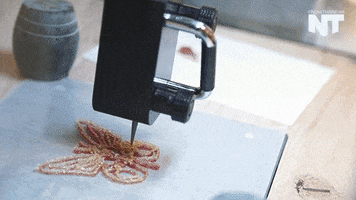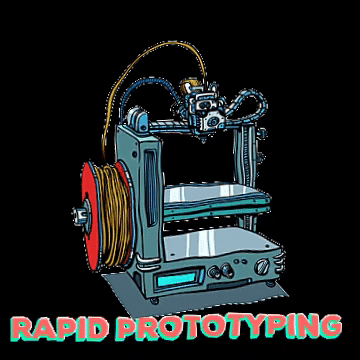3D printing is not just an innovative technology; it’s a potential goldmine for those looking to start a business or side hustle. With the ability to create custom products, prototypes, and parts on demand, 3D printing offers numerous avenues for entrepreneurs to tap into and make money.
In 2023 and beyond, 3D printing will keep innovating how businesses produce and buy goods, and ongoing challenges in the supply chain will further solidify its position as a crucial technology for solving economic and national security problems.
If you are someone who has the passion to build and create something, this side hustle is definitely something you want to start taking notes.
Key Takeaways
- Identify profitable niches and leverage online marketplaces like Etsy, Shapeways, and Thingiverse to sell unique 3D printed products.
- Offer high-quality 3D printing services to a targeted clientele, including businesses, individuals, and educational institutions.
- Create and monetize your 3D models by mastering modeling software and selling your designs on platforms like TurboSquid and CGTrader.
- Develop a comprehensive business plan and invest in quality equipment to start a 3D printing business that stands out in the market.
- Utilize 3D printing for rapid prototyping to collaborate with innovators, reduce costs for clients, and potentially expand into full-scale production.
how to make money 3d printing

To thrive in the 3D printing market, identifying a profitable niche is crucial. It’s about understanding what customers are passionate about and what they’re willing to pay for. Custom jewelry, personalized home decor, and prototyping services are often lucrative starting points.
When considering a niche, look at successful shops and their bestsellers. This can provide valuable insights into popular categories and items that are in demand. For example, a print-on-demand business model can be particularly effective, allowing for customized products with minimal upfront costs.
By focusing on a specific niche, you can tailor your marketing efforts and product development to meet the exact needs of your target audience, enhancing customer satisfaction and loyalty.
Remember, the goal is to find the intersection between your interests, market demand, and the unique value you can provide. This strategic approach can potentially lead to significant earnings, with some individuals earning up to $10,000 per month.

With the innovation of ChatGPT becoming the next big thing. It’s no surprise that the next generation of possibly multi-millionaires is going to be from AI.
If you are interested in learning more, be sure to click on the link below:
Choosing the Right Online Marketplaces
Selecting the appropriate online marketplaces is critical for the success of selling your 3D-printed products. Diverse customer bases are looking for unique items, and platforms like Etsy, Amazon Handmade, and Thingiverse cater to those seeking personalized products. Here’s a quick guide to help you decide:
- Research the audience demographics of each platform to ensure they align with your target market.
- Consider the fees and commission structures, as they can significantly affect your profit margins.
- Look into the ease of use and support provided by the marketplace for sellers.
It’s essential to not only choose a marketplace with a large audience but also one that aligns with the type of 3D printed items you sell.
Remember, the goal is to maximize visibility and sales potential while minimizing costs. Utilize platforms where industry professionals and potential clients gather, and actively showcase your portfolio. Additionally, investing in paid advertising can be a strategic move to reach a wider audience.
Marketing Your 3D Printed Products
To effectively market your 3D-printed products, it’s essential to establish a robust online presence. Begin by creating a professional website that highlights your products, services, and past projects. Optimize your site for search engines to improve visibility and attract more traffic.
Social media is a powerful tool for reaching a wider audience. Platforms like Facebook, Instagram, Twitter, and LinkedIn allow you to showcase your work and engage with potential customers. Consider these steps for social media marketing:
- Share high-quality images and videos of your products.
- Engage with your audience through comments and messages.
- Run targeted ads to reach specific demographics.
Content marketing can also drive interest and establish your brand as an authority in the 3D printing space. Create and share valuable content such as blog posts, tutorials, and case studies. Participate in online communities and forums to connect with enthusiasts and potential clients.
Leveraging various online platforms and marketing strategies can significantly enhance your product’s visibility and appeal to a broader customer base.
Lastly, don’t overlook the importance of industry-specific platforms where you can directly interact with potential clients and stay abreast of market trends. Paid advertising and local SEO optimization can further increase your reach, especially if you’re targeting a local market.
Looking for marketing services to help you boost awareness?
Here at HustleVenture, we are a finance and side hustle newsletter business. So if you are reading this, chances are, we can help you grow your side hustle/business through some of our online services such as:
- SEO writing [Popular⭐]
- Web design
- Videography [Singapore Only]
- Advertising [Popular⭐]
- Copywriting
- Guest post promotion
These are just some ways we can do to promote your business/side hustle. Interested to know more, be sure to schedule a Zoom call with us down below!

Providing 3D Printing Services

Targeting the Right Clientele
To thrive in the 3D printing service industry, identifying your target market is crucial. This involves understanding the needs and preferences of different market segments and tailoring your services accordingly. For instance, you might focus on architects needing detailed scale models or medical professionals seeking anatomical replicas for educational purposes.
- Architects: Require precision and detail for scale models.
- Medical Professionals: Need anatomical models for patient education.
- Educational Institutions: Seek tools for STEM education.
- Hobbyists: Look for custom parts and accessories.
By specializing in a niche, you can offer more personalized services and build a reputation as an expert in that area. Additionally, consider the following strategies to effectively reach your intended audience:
- Utilize industry-specific platforms to showcase your portfolio and engage with potential clients.
- Leverage social media platforms to share high-quality images and videos of your work.
- Invest in paid advertising to reach a wider audience, using platforms like Google Ads and social media.
By staying at the forefront of advancements and offering environmentally friendly solutions, you can appeal to a market segment that values innovation and sustainability.

Want to grow on social media but don’t want to spend hundreds of dollars?
Learn everything here with “Hook Point”. This book is the one-stop solution to learning and understanding how to capture your audience in the 21st century.
Setting Up a Service Model
When establishing a service model for your 3D printing services, it’s crucial to define the scope and structure of the offerings you plan to provide. Start by outlining the types of printing services you’ll offer, such as prototyping, custom designs, or production runs. Next, consider the pricing strategy that will cover your costs and remain competitive.
A clear service model should also include a streamlined process for order handling and fulfillment. This involves setting up an efficient workflow from the initial client consultation to the final delivery of the printed product. Communication channels should be established to keep clients informed throughout the process.
To ensure a successful service model, here’s a simple checklist:
- Determine the range of services offered
- Develop a pricing structure
- Set up an order management system
- Establish clear communication protocols
- Implement quality control measures
Remember, a well-defined service model is the backbone of a reliable and profitable 3D printing service. It sets clear expectations for your clients and lays the foundation for a scalable business.
Quality Assurance and Customer Satisfaction
Ensuring the highest quality in 3D printing services is not just about the technology used; it’s about the commitment to customer satisfaction. A robust quality assurance process, including the use of standardized test specimens and statistical process control (SPC) methods, is essential to maintain trust and reliability with your clients.
To build a good reputation and attract repeat business, it’s crucial to provide excellent customer service and maintain high standards in the variety of services offered.
Quality in 3D printing encompasses several factors:
- Hardware quality and repairability
- Precision and detail of prints
- Clean topology and optimized materials
- Customer support and ease of obtaining replacement parts
Remember, a satisfied customer is likely to become a recurring customer, contributing to the growth of your service-based business. Partnering with reliable manufacturers and prioritizing the customer experience will ensure the longevity of your custom solutions.
Creating and Selling 3D Models

To excel in creating and selling 3D models, mastering a variety of 3D modeling software is crucial. Each software has its strengths, and choosing the right one can significantly impact the quality and efficiency of your work. For instance, Blender is renowned for its robust features and supportive community, making it an excellent choice for animation and general 3D modeling.
- Blender: Best for animation and general 3D modeling
- 3D Xpert: Ideal for additive manufacturing
- Geomagic Design X: Top choice for reverse engineering
It’s essential to stay informed about the latest software developments and user reviews. Resources like G2 and TechRadar offer comprehensive reviews and rankings to help you make an informed decision. Moreover, investing time in learning through online courses can greatly enhance your skills. For example, the 10 Best Blender Courses for 2024 can be a valuable asset in your learning journey.
Embracing continuous learning and staying adaptable to new software advancements will keep your skills sharp and your models in demand.
Remember, the software is just a tool; it’s your creativity and understanding of the market that will truly make your models stand out. Researching profitable niches and aligning your designs with customer needs are key to success in the 3D modeling market.
Finding Buyers for Your Models
Once you’ve mastered the art of 3D modeling, the next step is to find buyers for your creations. A good starting point is to list your models on popular online marketplaces that cater to 3D content. Platforms like CGTrader offer a variety of pricing options, including auctions and custom quotes, which can provide flexibility and exposure for your work.
To increase your chances of making sales, it’s essential to have a well-crafted seller profile. On platforms like Sketchfab, completing your seller profile and ensuring your portfolio showcases your best work is crucial. Remember to self-identify as a Trader or Non-Trader as required by law, and provide any necessary information.
Establishing a strong online presence can significantly boost your visibility and attract potential buyers. Engage with the community, share your work on social media, and consider offering custom 3D modeling services to stand out.
Finally, keep an eye on industry trends and customer feedback to continuously improve your offerings. By doing so, you can maintain a competitive edge and build a loyal customer base.
Protecting Your Intellectual Property
When venturing into the realm of 3D printing, safeguarding your creations is paramount. Identify and protect your intellectual property, including any unique 3D printing designs or processes. Utilize trademarks, copyrights, and patents as appropriate to shield your work from unauthorized use and maintain competitive advantage.
To ensure comprehensive protection, consider the following steps:
- Conduct thorough research to avoid infringing on existing intellectual property.
- Register your designs and trademarks to establish legal ownership.
- Use clear contracts and agreements that stipulate intellectual property rights when collaborating with others.
- Stay informed about industry-specific regulations that may impact intellectual property rights in the 3D printing sector.
It’s crucial to understand the nuances of intellectual property law as it applies to 3D printing. Simply printing a copyrighted 3D design for personal use might not constitute infringement in some jurisdictions, but distributing, selling, or making it publicly available can lead to legal complications.
Remember, protecting your intellectual property is not just about legal compliance; it’s about ensuring the longevity and profitability of your business.
Starting a 3D Printing Business

A comprehensive business plan is the cornerstone of any successful 3D printing venture. It should detail your business structure, services, pricing strategy, and financial projections. Begin with a compelling executive summary to capture the essence of your business, followed by in-depth analyses of your company, industry, customer base, and competitors.
- Market Research: Understand market trends and customer needs, especially in industries like healthcare, manufacturing, and consumer goods.
- Cost Analysis: Provide a detailed breakdown of startup costs, including equipment, materials, and operational expenses.
- Revenue Projections: Estimate your earnings based on service pricing and market demand.
- Scalability: Plan for growth, addressing production capacity, workforce, and technology upgrades.
Incorporating scalability plans into your business model is crucial for adapting to market demands. Outline strategies for resource allocation and strategic partnerships to ensure smooth expansion.
Investing in Quality Equipment
Investing in the right 3D printer is a cornerstone of building a successful 3D printing business. It’s not just about purchasing the most expensive model; it’s about finding the printer that aligns with your business goals and the specific needs of your clientele.
By focusing on quality and performance, you can ensure that your 3D printing business stands out in a competitive market.
Consider the following factors when choosing a 3D printer:
- Print quality: High-resolution capabilities are essential for projects that require precision and a high-quality finish.
- Material compatibility: Advanced materials like composites and biodegradable polymers can expand your market reach.
- Scalability: As your business grows, your equipment should be able to keep up with increased demand.
For example, the MakerBot Replicator+ is recommended for small businesses due to its fast printing speed and dynamic task handling. Meanwhile, for those on a budget, the Creality Ender-3 offers a cost-effective solution without compromising on quality.
Navigating Legal and Regulatory Requirements
When starting a 3D printing business, it’s crucial to navigate the complex legal and regulatory landscape to avoid costly penalties and legal issues. Begin by choosing the right legal structure for your business, such as a sole proprietorship, partnership, LLC, or corporation, and register it accordingly. This decision will affect your liability, taxes, and ability to raise capital.
Next, ensure you have all the necessary permits and licenses. This may include a general business license, a tax identification number, and specialized permits depending on the nature of your 3D printing activities. For example, if you’re printing objects that will be used in construction, you’ll need to be aware of the legal risks since many jurisdictions lack specific laws regulating this use.
Compliance with safety standards is non-negotiable. Ensure your processes adhere to regulations concerning ventilation, fire safety, and material handling.
Stay informed about industry-specific regulations that may apply to your 3D printing business. Regularly consult with legal professionals and business advisors to mitigate potential risks and ensure ongoing compliance. Remember, legal requirements can vary greatly by location, so it’s essential to seek guidance tailored to your specific situation.
Using 3D Printing for Rapid Prototyping

Collaborating with innovators and inventors is a cornerstone for 3D printing businesses looking to stay at the forefront of technology and innovation. By forming strategic partnerships, businesses can leverage the strengths of each party to accelerate research and development efforts.
For example, a partnership between a 3D printing startup and a research institution can lead to groundbreaking innovations that push the boundaries of what’s possible with additive manufacturing.
By engaging in collaborative projects, 3D printing businesses not only contribute to the advancement of the industry but also open up new markets and applications. This proactive approach to collaboration is essential in an ecosystem where technology and creativity are rapidly evolving.
Here are some benefits of such collaborations:
- Access to specialized knowledge and cutting-edge technology
- Shared resources can lead to reduced costs and increased efficiency
- Potential to enter new industries such as healthcare, aerospace, and automotive
- Opportunities for co-venturing and creating mutually beneficial business partnerships
Businesses need to explore these collaborative opportunities as they can lead to a significant competitive advantage and foster a spirit of innovation within the company.
Reducing Costs and Lead Times for Clients
By leveraging 3D printing technology, businesses can significantly reduce costs and lead times for their clients. This is achieved through the elimination of the need for traditional tooling and molds, which not only cuts down on production time but also minimizes material waste.
Clients benefit from the ability to produce small or custom production runs as needed, which is more cost-effective and faster than conventional manufacturing methods. The table below illustrates a comparison between traditional and 3D printing methods in terms of cost and time savings:
| Manufacturing Method | Cost Savings | Time Reduction |
|---|---|---|
| Traditional | Low | Minimal |
| 3D Printing | High | Significant |
With 3D printing, businesses can offer rapid prototyping services that transform the way products are developed, from initial concept to final product. This not only enhances the prototyping process but also allows for more iterative and innovative designs.
Businesses need to communicate these advantages to potential clients, showcasing how 3D printing can lead to more efficient product development cycles and ultimately, a quicker time to market.
Expanding Services to Full-Scale Production
Once your 3D printing services have mastered rapid prototyping, the next logical step is to expand into full-scale production. This transition allows you to offer comprehensive solutions that go beyond the initial stages of design and development. By doing so, you can cater to clients looking for end-to-end manufacturing capabilities, thus opening up new revenue streams.
- Assess the market demand for full-scale production in your niche.
- Plan for scalability to accommodate larger orders and more complex projects.
- Invest in additional equipment and technology to support increased production capacity.
- Develop strategic partnerships with suppliers and other businesses to streamline operations.
Embracing full-scale production requires a significant shift in both mindset and business operations. It’s not just about having the right equipment; it’s about having the right processes and partnerships in place to handle the demands of large-scale manufacturing.
Remember, expanding your services to include full-scale production is not just a growth strategy—it’s a commitment to your clients’ success. By providing a seamless transition from prototyping to production, you become an integral part of their product development journey.
Starting your own 3d printing business?
The key to success lies in understanding the market, honing your skills, and consistently delivering quality products that meet the needs of your target audience.
Whether you’re a hobbyist looking to monetize your passion or an entrepreneur aiming for a lucrative venture, 3D printing offers a unique path to financial gain. Remember, turning your 3D printing skills into a profitable business requires dedication, strategic planning, and a willingness to adapt to the evolving demands of the industry.
If you need help with marketing, be sure to reach out to us!
Looking for marketing services to help you boost awareness?
Here at HustleVenture, we are a finance and side hustle newsletter business. So if you are reading this, chances are, we can help you grow your side hustle/business through some of our online services such as:
- SEO writing [Popular⭐]
- Web design
- Videography [Singapore Only]
- Advertising [Popular⭐]
- Copywriting
- Guest post promotion
These are just some ways we can do to promote your business/side hustle. Interested to know more, be sure to schedule a Zoom call with us down below!

Frequently Asked Questions
What are the most profitable 3D printing niches?
Profitable 3D printing niches include custom figurines, medical models, architectural models, specialized tools, automotive parts, and personalized gifts. Identifying a niche that aligns with your skills and market demand is crucial for success.
Where can I sell my 3D prints online?
You can sell your 3D prints on various online marketplaces such as Etsy, Shapeways, Thingiverse, and eBay. Each platform has its own audience and fee structure, so choose the one that best fits your business model.
How do I ensure high-quality 3D printing services?
To ensure high-quality 3D printing services, invest in a reliable 3D printer, use premium materials, perform regular maintenance, and establish a quality control process to check prints before delivery.
How can I protect my 3D model designs from being copied?
To protect your 3D model designs, consider using copyright and patent laws where applicable, implementing digital rights management (DRM), and using watermarking or other techniques to trace unauthorized copies.
What do I need to start a 3D printing business?
To start a 3D printing business, you’ll need a detailed business plan, quality 3D printing equipment, a strong understanding of the market, and compliance with legal and regulatory requirements.
How does 3D printing for rapid prototyping benefit clients?
3D printing for rapid prototyping benefits clients by significantly reducing the time and cost associated with developing prototypes, allowing for faster iteration and innovation, and potentially leading to full-scale production partnerships.





